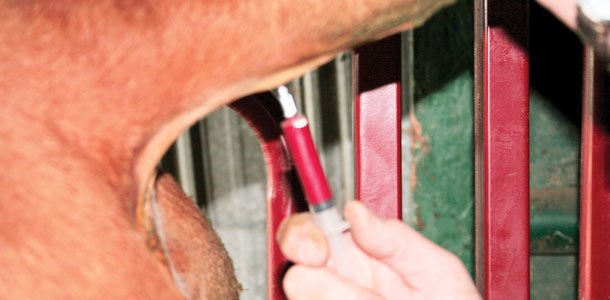This has left the feeder cattle market very tight. The tightness of this market provides producers a potential opportunity to maximize the return on their investment by determining the pregnancy status of females more frequently and earlier post-breeding.
This article will focus on heifers and how adopting this practice will allow producers to increase their return on investment.
There are three main areas that a producer can gain. First, I will focus on the opportunity of increased sale prices by marketing open heifers earlier; second, the ability to know A.I. versus natural-service breeding; and finally examine the use of preg-checking in youngstock and how this knowledge is valuable prior to a heifer entering either the feeding phase (marketed at weaning) or breeding phase (retained as a replacement) of the production cycle.
Early post-breeding
Determining whether an animal conceived early post-breeding has tremendous value in future management of that animal and in the financial return a producer can receive.
There are three methods available to producers to determine the pregnancy status of heifers: rectal palpation, ultrasonography and chemical pregnancy tests.
Rectal palpation is the traditional method for determination of pregnancy status. Using this procedure, the uterus is manually examined for signs of pregnancy.
Traditionally, this can be performed as early as 30 to 35 days post-breeding by an experienced palpator.
Recently, ultrasonography has become more popular. Ultrasonography – or ultrasounding – is the use of a rectal probe to examine the uterus for signs of pregnancy.
Ultrasounds can be used for examinations earlier than rectal palpation but still cannot be used prior to 26 to 28 days post-breeding.
In recent years, new technologies have been developed that evaluate blood samples for pregnancy status.
These tests analyze a sample of blood for the presence of proteins that are produced only by the placenta of the growing fetus and released into the maternal bloodstream.

These tests determine the presence of these pregnancy-specific proteins in the maternal blood. Pregnancy status is then determined based on the presence, or lack thereof, of these proteins in the blood sample.
To check for pregnancy this way, a producer or veterinarian sends a sample of blood from the cow to a laboratory near them as early as 28 days post-breeding and in lactating cows 73 days post-calving.
Tests are more than 99 percent accurate when a cow is determined to be open. Once the heifer is determined to be open, she can then be re-bred or marketed accordingly.
Heifers should have a short breeding season. At the end of the breeding season, females need to be sorted and culled based on fertility and efficiency.
If it takes a female a long period of time to breed at this age, they are not the animal you want to base the future profitability of your operation on.
This means when a preg check occurs and she is open, she needs to be removed from the herd and marketed. The timing of this check is crucial to maximizing the return on investment.
Furthermore, determination of the pregnancy status of a female early in the breeding season after one round of A.I. and cleanup bulls, or just a bull exposure for a short period of time, allows the animal to be marketed early.
By marketing early, the heifer may still qualify for the feeder calf market, allowing her to qualify for higher prices.
This also allows the heifer to be marketed in July or August, in a spring- calving situation, when prices are generally higher than later in the fall or winter, when the market is flooded with the weaned calf crop.
A.I. versus natural service
Checking the status of heifers during bull exposure but early after A.I. will allow for the determination of those that conceived to A.I.
The first step in this process is to not place the cleanup bull in until 15 days post-A.I. The breeder then checks for pregnancy at 28 days post-breeding.
The ultrasound technician or blood test will not detect those animals that are short-bred by the bull but will be able to determine the status on those that had conceived to A.I.
Additionally, producers can benefit from frequent checks by placing groups of heifers that are guaranteed to calve at a certain time for management or marketing.
This is done by checking the open heifers from the previous pregnancy check 28 days later to find those that were bred during that next cycle.
Post-weaning
It may be a paradigm shift, but preg-checking weanling cattle can offer management gains. Typically, from 3 to as much as 15 percent of heifers entering feedlots are pregnant on arrival.
This indicates there are a large number of heifers being bred as calves by the cleanup bull. In the feedlot, a pregnant heifer has reduced feed efficiency and reduced dressing percentage, leading to reduced returns.
As a replacement heifer, she will calve at an inopportune time in her growth development and in the production cycle. A pregnancy early in a heifer’s life can lead to a lower production over her lifetime.
The livestock producer would begin this process by weaning the heifers and separating them from any male animals.
He then can determine the heifer’s pregnancy status as early as 28 days after separating the animals.
This determination can be done this early using any of the methods listed above. The livestock producer can then manage the animals that are open or pregnant accordingly.
In today’s production environment, producers need to examine each tool they have at their disposal and determine which can aid them in improving their production system to maximize their returns. ![]()
Jeremy Howard is a reproduction specialist with BioTracking and can be contacted by email at or at (208) 882-9736.
PHOTOS
TOP: Development of heifers begins by weaning them and separating them from any male animals.
BOTTOM: Blood testing is more than 90 percent accurate when a cow is determined to be open. Photos courtesy of Filament Marketing.

Jeremy Howard
Reproduction Specialist
BioTracking LLC








